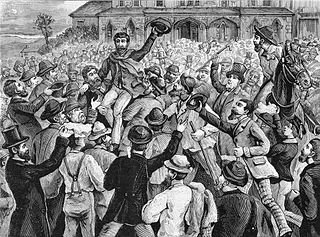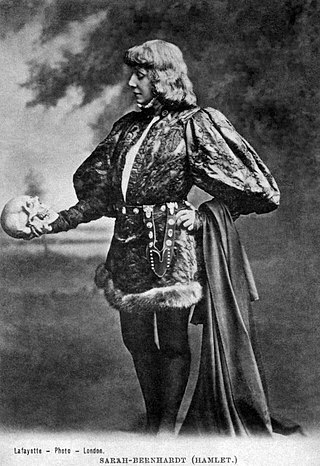In logic, the law of excluded middle states that for every proposition, either this proposition or its negation is true. It is one of the so-called three laws of thought, along with the law of noncontradiction, and the law of identity. However, no system of logic is built on just these laws, and none of these laws provides inference rules, such as modus ponens or De Morgan's laws.

A false dilemma, also referred to as false dichotomy or false binary, is an informal fallacy based on a premise that erroneously limits what options are available. The source of the fallacy lies not in an invalid form of inference but in a false premise. This premise has the form of a disjunctive claim: it asserts that one among a number of alternatives must be true. This disjunction is problematic because it oversimplifies the choice by excluding viable alternatives, presenting the viewer with only two absolute choices when in fact, there could be many.
A loaded question is a form of complex question that contains a controversial assumption.
In logic, the semantic principleof bivalence states that every declarative sentence expressing a proposition has exactly one truth value, either true or false. A logic satisfying this principle is called a two-valued logic or bivalent logic.
A paradox is a logically self-contradictory statement or a statement that runs contrary to one's expectation. It is a statement that, despite apparently valid reasoning from true premises, leads to a seemingly self-contradictory or a logically unacceptable conclusion. A paradox usually involves contradictory-yet-interrelated elements that exist simultaneously and persist over time. They result in "persistent contradiction between interdependent elements" leading to a lasting "unity of opposites".

A jury is a sworn body of people (jurors) convened to hear evidence, make findings of fact, and render an impartial verdict officially submitted to them by a court, or to set a penalty or judgment.
Judgement means the evaluation of evidence to make a decision. Judgement is also the ability to make considered decisions. The term has at least five distinct uses.

In common law jurisdictions, an acquittal means that the prosecution has failed to prove that the accused is guilty beyond a reasonable doubt of the charge presented. It certifies that the accused is free from the charge of an offense, as far as criminal law is concerned. The finality of an acquittal is dependent on the jurisdiction. In some countries, such as the United States, an acquittal prohibits the retrial of the accused for the same offense, even if new evidence surfaces that further implicates the accused. The effect of an acquittal on criminal proceedings is the same whether it results from a jury verdict or results from the operation of some other rule that discharges the accused. In other countries, like Australia and the UK, the prosecuting authority may appeal an acquittal similar to how a defendant may appeal a conviction — but usually only if new and compelling evidence comes to light or the accused has interfered with or intimidated a juror or witness.
In law, a summary judgment, also referred to as judgment as a matter of law or summary disposition, is a judgment entered by a court for one party and against another party summarily, i.e., without a full trial. Summary judgments may be issued on the merits of an entire case, or on discrete issues in that case. The formulation of the summary judgment standard is stated in somewhat different ways by courts in different jurisdictions. In the United States, the presiding judge generally must find there is "no genuine dispute as to any material fact and the movant is entitled to judgment as a matter of law." In England and Wales, the court rules for a party without a full trial when "the claim, defence or issue has no real prospect of success and there is no other compelling reason why the case or issue should be disposed of at a trial."
Dialetheism is the view that there are statements that are both true and false. More precisely, it is the belief that there can be a true statement whose negation is also true. Such statements are called "true contradictions", dialetheia, or nondualisms.
In classical logic, intuitionistic logic and similar logical systems, the principle of explosion, or the principle of Pseudo-Scotus, is the law according to which any statement can be proven from a contradiction. That is, from a contradiction, any proposition can be inferred; this is known as deductive explosion.
Causation in English law concerns the legal tests of remoteness, causation and foreseeability in the tort of negligence. It is also relevant for English criminal law and English contract law.
In linguistics and philosophy of language, an utterance is felicitous if it is pragmatically well-formed. An utterance can be infelicitous because it is self-contradictory, trivial, irrelevant, or because it is somehow inappropriate for the context of utterance. Researchers in semantics and pragmatics use felicity judgments much as syntacticians use grammaticality judgments. An infelicitous sentence is marked with the pound sign.

The Italian Code of Criminal Procedure contains the rules governing criminal procedure in every court in Italy. The Italian legal order adopted four codes since the Italian Unification. After the first two codes, in 1865 and 1913, the Fascist Government established in 1930 a new code adopting an inquisitorial system. In 1988 the Italian Republic adopted a new code, that could be considered to be somewhere in between the inquisitorial system and the adversarial system.
Cultural consensus theory is an approach to information pooling which supports a framework for the measurement and evaluation of beliefs as cultural; shared to some extent by a group of individuals. Cultural consensus models guide the aggregation of responses from individuals to estimate (1) the culturally appropriate answers to a series of related questions and (2) individual competence in answering those questions. The theory is applicable when there is sufficient agreement across people to assume that a single set of answers exists. The agreement between pairs of individuals is used to estimate individual cultural competence. Answers are estimated by weighting responses of individuals by their competence and then combining responses.
Majority judgment (MJ) is a single-winner voting system proposed in 2010 by Michel Balinski and Rida Laraki. It uses a highest median rule, i.e., a cardinal voting system that elects the candidate with the highest median rating.
Indonesia is a civil law country with five major codes. Its criminal procedure code, the Kitab Undang-Undang Hukum Acara Pidana ("KUHAP"), determines the procedures and rights of individuals at different stages of the trial process.

The paradox of fiction, or the paradox of emotional response to fiction, is a philosophical dilemma that questions how people can experience strong emotions to fictional things. The primary question asked is the following: How are people moved by things which do not exist? The paradox draws upon a set of three premises that seem to be true prima facie but upon closer inspection produce a contradiction. Although the emotional experience of fictional things in general has been discussed in philosophy since Plato, the paradox was first suggested by Colin Radford and Michael Weston in their 1975 paper "How Can We Be Moved by the Fate of Anna Karenina?". Since Radford and Weston's original paper, they and others have continued the discussion by giving the problem slightly differing formulations and solutions.
Belief merging, also called belief fusion or propositional belief merging, is a process in which an individual agent aggregates possibly conflicting pieces of information, expressed in logical formulae, into a consistent knowledge-base. Applications include combining conflicting sensor information received by the same agent and combining multiple databases to build an expert system. It also has applications in multi-agent systems.






